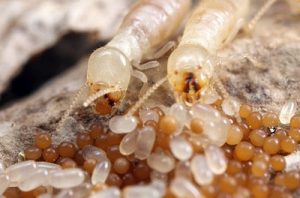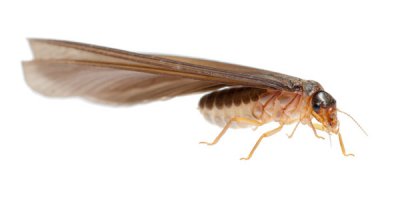
Termites are a serious threat to houses, and like any other creatures these insects have several life stages.
Termites start their life cycle from eggs which appear after the most important part of termites’ life: copulation.
In middle latitudes females lay fewer eggs and pauses between batches are more continuous: in the Northern hemisphere they last from autumn to spring, and in Southern – from spring to autumn.
Hide content
- What do termite eggs look like?
- Photo
- Life in the nest
- Nutrition eggs
- How to find?
- Termite prevention
- Useful articles
- Useful video
- Conclusion
What do termite eggs look like?
They are jelly like and may be of white, clear and yellowish color. Termite eggs sacs are very small, but can be seen with naked eyes, but you will never find them in visible areas as they are located in protected areas of the nest.
At the beginning the queen lays 10-20 eggs, but their number rises slowly and reaches thousands of eggs per day.
A Termite nest is full of small yellow eggs which look like caviar. Termites move them from place to place. Workers may collect eggs in clutches or spread them all over the nest’s bottom in a thin layer.
But that’s the way they look like in big nests. In the nest with the number of eggs not more than 12, the clutch looks like tiny semitransparent grain. Usually this grain grows up not only because of growing eggs’ number but also because each egg swells.
Termite eggs hatch and larvae appears. Termites are very slow in growth. Larvae will appear only 30-60 days after (depending on a temperature).Photo
You can see termites eggs photos. It can help you to find enemies in the house.
Life in the nest
If the queen and the king do not die during drought or heavy rains and flood, if they were not eaten by their enemies, new eggs appear.
After mating the queen can be up to 100 times bigger than the other termites. She is so full of eggs that she can hardly move and will never leave the nest. The workers feed and clean her.
Attention! Healthy termite queens can produce up to 30,000 eggs a day.Mother’s stomach starts contracting and the “wave” inside pushes out the first egg. After that the queen rests.
At the beginning the difference in time between eggs may be quite serious. Sometimes a week (and even more) passes when the second egg appears. The same time is needed for the third egg. All the time the king and the queen are licking and cleaning eggs while expecting new termites.
When mother lays eggs, it provides the nest with almost identical termites which look almost the same. It is not clear what kind of termite is sitting in the egg: it doesn’t belong to any caste.
Every new egg is taken by one of the termites. Termite takes the egg with mandibles and carries it away, washes it with saliva, cleans and passes to another termite; or carries the egg further, again cleans and takes it to one of the nest “rooms”.
Usually other termites stay in the place where the queen lives, lick and stroke mother’s stomach while it lays new egg.
Nutritional chemicals that saliva contains are soaked through egg’s cover. That’s why after some time the eggs’ size grows.
The more workers give food to the queen, the more eggs it lays.
Learn more about drywood termites: signs of their activity; best methods of treatment: spot treatment and DIY methods; how to get rid of them in furniture?Nutrition eggs
The queen can eat one of the eggs which she laid. Sometimes the king may participate in the process. But there is no place for cannibalism (the act of termites eating other termites).
Eggs (which mother eats) have no embryo, which means that they can’t grow. Today this special type of eggs is called trophic eggs. These eggs are laid not for reproduction but for nutrition functions.
In tropics the queen may lay eggs during the whole year, having rest during rainy season. Usually termite queen lays eggs every minute, but there are some termite types where the mother can have eggs every 10-20 seconds, or even every 2-3 seconds.
Learn more about subterranean termites: signs of their activity; best methods of treatment and DIY methods. Eastern subterranean termites and their tunnels and tubes with photo.
How to find?
You won’t discover eggs in your home; they are going to be in the clump of the nest of the actual colony, which would be in the ground. Where do termites lay eggs? You’d have to dig pretty far deep in the ground to find the eggs. So it’s not something you have to look for around your house.
Another thing about eggs is that the queen lays thousands of eggs a day. So the nest can grow pretty fast. So when you do find termites it’s not something you want to know, have it treated right that day but it’s something you do want to get taken care of right away within a week or two.
Termite prevention
If you want to find the best solution for termite prevention, try looking for any water leaks. If you have any type of water damage or water leak, get it fixed immediately.
Ninety five percent of all termite treatment that is done is from some sort of water leak or water damage which householders have in the home (from a drippy faucet or a drippy water heater). Make sure you get those water leaks fixed.
Another way to keep termites from coming into the home is to keep any wood or timber away from the house. Eliminate wood to earth contact and the adverse conditions that are conducive to infestation. The same is with the outside water leaks. If you have a leaky faucet, broken sprinkler, try to get them fixed.
Attention! Any type of high moisture content will attract termites into the home.Here you can learn more information about effective treatment method called tenting (fumigation): dangers for termites, preparing for fumigation and cleaning after, how long does this procedure last?
Useful articles
If you interested in more information of termites we recommend you to read the following articles:
- All types of termites. Are they harmful to humans? Can they bite you? And what is the difference between drywood and subterranean ones?
- What does swarmers of different species look like: drywood, subterranean, formosan?
- Signs of infestation outside and in the house: in walls or furniture.
- What does termite holes look like? What is droppings and is it toxic to humans? Do termites make noises?
- Posible termite damage, how does it look like? Examples of damage in walls and wood floors.
- All about flying termites: how do they look like, swarming season and what to do if there are swarmers in your house?
- How do they do nests and mounds? How to find it in your garden or inside the house?
- Here you can learn more information about effective termite control remedies: Bora-Care, Boric acid, Borate, Fipronil, Chlorpyrifos, Chlordane.
Useful video
About termite prevention we have a video. Please watch it:
Conclusion
In order to have no problems with termites or their future appearance make sure you get a professional advice. Call pest company and find their recommendations for your area. Controllers do a full exterior treatment of the home to keep any termites from ever coming in, and keep any nests from starting to come into the home.



